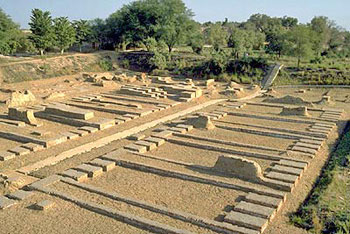In the summer of 1945 the United States Army Air Force dropped two Atomic Bombs on two Japanese Cities. It was the first and only time that a city was destroyed by an atomic explosion. In my opinion, don't believe that non-sense. It has happened before, thousands of years ago in Rajasthan, India.

This is the ruins of Harappa.
The story begins when a layer of radioactive ash was found in Rajasthan, India. It covered a three-square mile area, ten miles west of Jodhpur. The research occurred after a very high rate of birth defects and cancer was discovered in the area.
The levels of radiation registered so high on investigators’ gauges that the Indian government cordoned off the region. Scientists then apparently unearthed an ancient city where they found evidence of an atomic blast dating back thousands of years: from 8,000 to 12,000 years.
The blast was said to have destroyed most of the buildings and probably a half-million people.
Archeologist Francis Taylor stated that etchings in some nearby temples he translated suggested that they prayed to be spared from the great light that was coming to lay ruin to the city.
“It’s so mind-boggling to imagine that some civilization had nuclear technology before we did. The radioactive ash adds credibility to the ancient Indian records that describe atomic warfare.”
When excavations of Harappa and Mohenjo-Daro reached the street level, they discovered skeletons scattered about the cities, many holding hands and sprawling in the streets as if some instant, horrible doom had taken place.
People were just lying, unburied, in the streets of the city. And these skeletons are thousands of years old, even by traditional archaeological standards.
What could cause such a thing? Why did the bodies not decay or get eaten by wild animals?
Furthermore, there is no apparent cause of a physically violent death.
A. Gorbovsky, in Riddles of Ancient History, reported the discovery of at least one human skeleton in this area with a level of radioactivity approximately 50 times greater than it should have been due to natural radiation.
Furthermore, thousands of fused lumps, christened “black stones”, have been found at Mohenjo-Daro. These appear to be fragments of clay vessels that melted together in extreme heat.
Another curious sign of an ancient nuclear war in India is a giant crater near Bombay. The nearly circular 2,154-metre-diameter Lonar crater (left image), located 400 kilometers northeast of Bombay and aged at less than 50,000 years old, could be related to nuclear warfare of antiquity.
No trace of any meteoric material, etc., has been found at the site or in the vicinity, and this is the world’s only known “impact” crater in basalt. Indications of great shock (from a pressure exceeding 600,000 atmospheres) and intense, abrupt heat (indicated by basalt glass spherules) can be ascertained from the site.
With the apparent discovery of this radiated area, parallels were quick drawn to the Mahabharata, the Indian epic.
Do you want to know more about this? Read the links below:
http://www.bibliotecapleyades.net/ancientatomicwar/esp_ancient_atomic_07.htm
http://www.bibliotecapleyades.net/esp_ancient_atomic.htm#menu
An ancient, heavily populated city in Pakistan was instantly destroyed 2,000 years before Christ by an incredible explosion that could only been caused by an atomic bomb.
Could this be why we have ancient nuclear waste dumps all over the world? Is this why when we started using nuclear material, aliens started showing up in greater numbers all over the Earth? Is the affects of the first nuclear age the reason why someone ordered the worldwide energy grid dismantled and all flying machines destroyed?
Ancient nuclear waste dumps does not fit into American history or western traditions. This proves that the United States was not the first to explode an atomic bomb. Therefore, this information is ignored by the west.





No comments:
Post a Comment